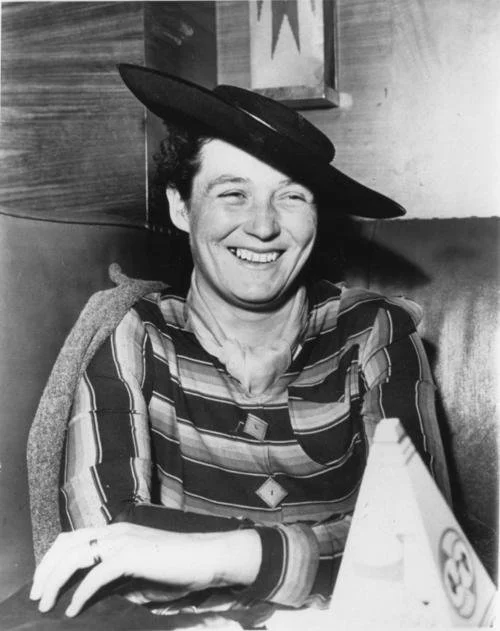Los Gatos has been home to many artistic and cultural luminaries over its history, many of whom were and are women. This year, for National Women’s History Month, we are highlighting just a few of these notable women.
Ruth Comfort Mitchell.
Ruth Comfort Mitchell was born in San Francisco in 1882. She spent the summers of her childhood in Los Gatos, where her parents and grandparents had summer homes. Ruth’s literary career began at the age of 14, when the Los Gatos Mail published her first poem. She would go on to have a long and illustrious career as a writer, and wrote numerous novels, short stories, plays, and poems throughout her lifetime. Due to both her success as an author and her husband, State Senator Sanborn Young, Ruth had connections to many influential political and artistic people, including President Herbert Hoover, Gertrude Stein, Fremont Older, and Senator James Phelan. The couple often hosted these friends at their Los Gatos home, the Yung See San Fong House, which means “Young’s Home in the Heart of the Hills,” and was aesthetically inspired by Chinese architecture. Ruth was an active participant in Republican politics, participating in numerous campaigns, and twice serving as a delegate to the Republican National Convention. Perhaps her greatest known work was her novel, Of Human Kindness, published in 1940 in direct opposition to John Steinbeck’s Grapes of Wrath. Ruth’s husband had become a rancher when he retired from politics, and they felt that Steinbeck’s novel did not tell the whole story; thus, she wrote her novel to tell the landowner’s side of the Dust Bowl migration story, highlighting the trials and tribulations landowners faced that were brought on by migrant workers and union organizers. Ruth was an active member of the Los Gatos community her entire life, and was involved with the Los Gatos Pageant, the Los Gatos History Club, and the Christian Science Church of Los Gatos. She died in her Los Gatos home in 1954.
Carol Henning Steinbeck. Courtesy of The Martha Heasley Cox Center for Steinbeck Studies at San Jose State University.
Carol Henning Steinbeck was born in San Jose, in 1906. She met her future husband John Steinbeck in Lake Tahoe in 1928, after he left Stanford University and was working as a tour guide. The two fell in love instantly, and got married in 1930, forming a creative partnership that would result in many of John’s great novels. Carol and John were reportedly well-suited, and had a very symbiotic relationship; she was outgoing and inquisitive where he was shy and introspective. She was creative in her own right, producing whimsical artwork and poetry, and she left her job as a secretary in San Francisco to become her husband’s typist, editor, and intellectual partner; together they worked and struggled to bring forth John’s novels that addressed their common social causes. The two built a home and briefly lived in Los Gatos beginning in 1936, when John wrote The Grapes of Wrath - which Carol named, taking inspiration from Julia Ward Howe’s Battle Hymn of the Republic. However, once The Grapes of Wrath and John Steinbeck became successes in equal measure, and the goals of both Carol and John had been achieved, their marriage began to suffer. Carol and John divorced in 1942, and although Carol later remarried, not much is publicly known about her life post-John Steinbeck. Carol died in 1983, and thanks to recent scholarship, is receiving more recognition and credit for the role she played in producing some of the greatest American literature of the 20th century.
Marcellite Garner Wall.
Marcellite Garner Wall was born in 1910 in Redlands, California. In 1930, she began working at the small, 35-person Walt Disney Productions studio. Marcellite started out as a cell painter and inker in Disney’s ink and paint department, and six months later was selected to be the voice of Minnie Mouse; because Minnie was scheduled to play a Mexican character in an upcoming film, the character need to be able to speak Spanish, and Marcellite was the only Disney employee who could both speak Spanish and sing. Thus began Marcellite’s 10 year and 40 film career as the voice of Minnie Mouse, being credited with defining Minnie’s personality and character. However, her roles as Minnie Mouse were just a side gig at Disney, for which she received $15 per film, while she continued to do most of her work in the art department. After Marcellite left Disney in 1941, she and her family moved to Los Gatos, where she and her husband, Richard Wall, worked on small theatrical and operatic stage productions with the Los Gatos Bowl Association, a group that put on a variety of cultural productions in the 1940s. She performed as part of a vocal trio called the Los Gatos Harmonettes and continued her illustrative career by producing the comic strip El Gato for the Los Gatos Times-Observer. Marcellite died in Grass Valley in 1993.
NUMU’s past exhibit Mitchell vs. Steinbeck delved deeper into the authors’ conflicting narratives on the Great Depression and the Dust Bowl.




